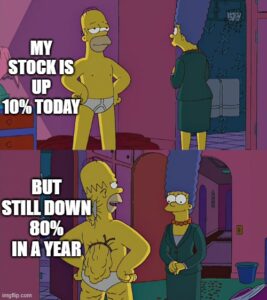What is a dead cat bounce and how can you identify one?
![]() Nick Sundich, November 5, 2024
Nick Sundich, November 5, 2024
The term dead cat bounce has gained popularity in recent years. And there have been plenty of examples of this phenomenon on the ASX. So, we thought we’d write an article to explore what exactly is a dead cat bounce in relation to stock investing.
What is a dead cat bounce?
The term “dead cat bounce” is often used to describe a temporary recovery in stock prices after a significant and prolonged decline. It implies that even a dead cat would bounce if it fell from a great height.
In other words, the stock may experience a brief uptrend before resuming its downward trend. This phenomenon is typically seen as a false signal of recovery and can often lead investors to make misguided investment decisions. They think a company is headed in the right direction now because of a temporary spike. However, it fell for a reason, and that reason may still be true.

How and why do they happen?
A dead cat bounce can occur for various reasons, such as short-covering or bargain hunting. Short-covering refers to when investors who have previously bet against the stock (short-sellers) close their positions, resulting in a temporary increase in the stock price.
On the other hand, bargain hunting occurs when investors see an opportunity to buy a stock at a lower price and believe it will eventually recover. If investors do get it right, they can make a significant profit. But if they buy in too early, they can join a very large club of people to have blown money on that stock.
Examples of dead cat bounces
Some famous examples include the dot-com bubble burst in 2000, where many technology stocks experienced a temporary recovery before ultimately crashing again. Another notable example is the housing market crash of 2008, where financial stocks experienced a dead cat bounce before continuing their downward trend.
Other notable individual stock examples include Enron in 2001, General Electric in 2018, and more recently, Hertz in 2020. These companies all experienced significant declines in their stock prices and saw temporary uptrends before ultimately facing further decline.
It is essential to note that these are just a few examples, and there have been many more instances of dead cat bounces throughout the history of stock investing. Therefore, it is crucial for investors to stay vigilant and not rely solely on past events when making investment decisions. Instead, thorough research and analysis should always be the foundation of any investment strategy.
Risks Involved
While a dead cat bounce may seem like a positive sign for investors, there are significant risks involved. As mentioned earlier, it can lead to misguided investment decisions as some investors may see it as a sign of long-term recovery. However, the stock price may continue to decline after the temporary uptrend, causing losses for those who bought during the bounce.
How to Identify a Dead Cat Bounce
Identifying a dead cat bounce can be challenging, but there are some indicators that investors can look out for. One common indicator is heavy trading volume during the temporary uptrend, which suggests that short-sellers are covering their positions.
Additionally, investors should also pay attention to any news or events that may have caused the initial decline in stock prices. Are the catalysts that caused the decline all over, or just forgotten temporarily by investors? And is the reason the stock price rise a legitimate value-creator in the longer term?
Conclusion
In conclusion, a dead cat bounce is a term used to describe a temporary recovery in stock prices after a significant and prolonged decline. While it may seem like a positive sign for investors, it is crucial to understand the risks involved and not make hasty investment decisions based on this phenomenon.
As with any investment, thorough research and analysis are essential in making informed decisions. So, next time you come across the term “dead cat bounce”, remember to approach it with caution and carefully consider all factors before making any investment moves.
What are the Best ASX Stocks to invest in right now?
Check our ASX stock buy/sell tips
Blog Categories
Get Our Top 5 ASX Stocks for FY25
Recent Posts
Uber (NYSE:UBER): Finally mature and profitable, but with more growth to come
More than a decade and a half since it was founded, Uber (NYSE:UBER) is finally a mature company. It has…
Are CBA shares overvalued at $300bn? Here’s 4 arguments why they are, 4 reasons why they aren’t and our judgement
Are CBA shares overvalued? This has a hotly contested question for many months and particularly now that it is capped…



